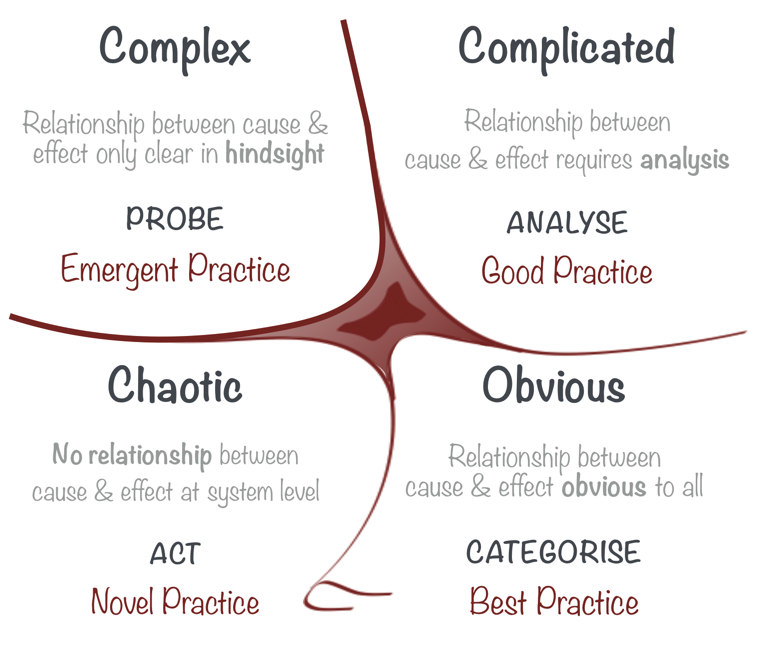(Terjemahan Bahasa Cina: Scrum:Apa itu kerangka Cynefin?) (Bahasa Jepang)
Meskipun Scrum dapat menjadi kerangka yang efektif untuk berbagai jenis proyek, penting bagi Anda untuk menyadari bahwa itu bukanlah obat mujarab untuk semua jenis proyek — itu bisa menjadi solusi yang sangat baik untuk banyak situasi di organisasi Anda tetapi mungkin bukan jawaban yang tepat dalam beberapa skenario. Sebuah kerangka yang dikenal sebagai Cynefin membantu kita untuk memahami situasi yang akan kita temui dalam skenario proyek.
Inti dari metode Scrum adalah untuk memungkinkan seluruh tim secara konsisten menghasilkan pekerjaan berkualitas melalui proses pengembangan yang ketat namun fleksibel dalam situasi di mana persyaratan tidak sepenuhnya diketahui atau dapat dipercaya. Organisasi mandiri memungkinkan tim proyek untuk menghasilkan solusi yang akurat dan tepat sementara batasan pasar dapat berubah secara tidak terduga.
Kerangka Cynefin?
Kerangka Cynefin, sebuah kata dalam bahasa Welsh untuk habitat, adalah kerangka konseptual yang digunakan untuk membantu pengambilan keputusan yang dibuat pada tahun 1999 oleh Dave Snowden. Ini menawarkan lima konteks pengambilan keputusan sebagai:
- sederhana,
- rumit,
- kompleks,
- kacau, dan
- kekacauan
Kerangka Cynefin membantu manajer untuk mengidentifikasi bagaimana mereka mempersepsikan situasi dan memahami perilaku mereka sendiri dan orang lain. Ini mengacu pada penelitian tentang teori sistem, teori kompleksitas, teori jaringan, dan teori pembelajaran.

Perhatikan kemungkinan domain skenario kekacauan ini dalam proyek Anda untuk mengetahui apakah Scrum akan cocok untuk Anda atau tidak:
- Sederhana
Dalam domain sederhana, kita berada dalam sistem teratur di mana hubungan antara sebab dan akibat ada, dapat diprediksi sebelumnya dan jelas atau terlihat oleh orang yang masuk akal.
Kami menerapkan praktik terbaik dan pendekatannya adalah:
INDRA — KATEGORIKAN — RESPON
- Indra — Lihat apa yang akan datang
- Kategorikan — Sesuaikan dengan kategori yang telah ditentukan
- Respon — Tentukan apa yang harus dilakukan
Skenario sederhana adalah situasi di mana semua orang dapat melihat sebab dan akibat — orang tahu apa jawaban yang benar. Jenis domain ini paling baik untuk mereproduksi produk berulang kali karena ada langkah-langkah yang dapat Anda ulangi untuk menyelesaikan masalah yang ada.
Meskipun Scrum dapat menjadi cara untuk menangani jenis domain skenario ini, Anda dapat mencapai hasil yang lebih cepat dan lebih pasti dengan kerangka jalur perakitan karena Anda memiliki praktik terbaik yang sah di mana saja.
2. Rumit
Kami menerapkan praktik baik dan pendekatannya adalah:
INDRA — ANALISIS — RESPON
- Indra— Lihat apa yang akan datang
- Analisis — Selidiki atau analisis, menggunakan pengetahuan ahli
- Respon — Tentukan apa yang harus dilakukan
Skenario rumit sering didominasi oleh para ahli untuk memastikan praktik baik dalam sebuah proyek. Meskipun ada kemungkinan memiliki beberapa jawaban, memiliki seorang ahli untuk mendiagnosis masalah akan lebih efisien dalam menangani skenario yang memiliki beberapa kemungkinan hasil. Scrum dapat digunakan untuk menyelesaikan skenario seperti ini, tetapi tentu saja, itu mungkin tidak selalu menjadi kerangka terbaik untuk digunakan.
Sebagai contoh, jika Anda perlu menyesuaikan parameter dalam mengoptimalkan kinerja, Anda mungkin tahu langkah terbaik yang harus diambil ketika Anda mengumpulkan para ahli untuk melihat situasi, memeriksa opsi yang tersedia, dan menghasilkan respon berdasarkan pengalaman mereka tentang apa yang seharusnya menjadi praktik baik. Skenario rumit paling baik diselesaikan melalui pendekatan kuantitatif dan taktis seperti Six Sigma.
3. Kompleks
PENYELIDIKAN — INDRA — RESPON
- Penyelidikan — Input eksperimental
- Indra — Kegagalan atau keberhasilan
- Respon— Tentukan apa yang harus dilakukan yaitu. memperkuat atau meredam
Masalah kompleks membuat Anda menyadari bahwa ada lebih banyak hasil yang tidak terduga daripada yang dapat Anda harapkan dari pendekatan Anda, dan di domain ini, Anda lebih mungkin mendapatkan jawaban yang benar ketika Anda memperbaiki kesalahan atau melihat kembali.
Ini mengharuskan Anda untuk menjelajahi sebanyak mungkin tentang masalah tersebut, memeriksa apa yang berfungsi atau tidak, dan kemudian beradaptasi berdasarkan apa yang telah Anda pelajari. Ini juga merupakan domain yang akan Anda temui ketika Anda mencoba melakukan inovasi atau melakukan peningkatan untuk proyek sebelumnya yang memerlukan fitur yang lebih baik.
Ini adalah domain di mana Scrum benar-benar bersinar, karena situasi kompleks memanfaatkan kemampuan Anda untuk menyelidiki situasi dan memeriksa apa yang dapat Anda lakukan dalam kerangka waktu tertentu. Ketika Anda belajar metode yang lebih baik dalam proses iterasi, maka Anda dapat mengadaptasinya pada kotak waktu iterasi berikutnya.
4. Kacau
Kami menemukan praktik baru dan pendekatannya adalah:-
AKTIF — INDRA — RESPON
- Bertindak — Usahakan untuk menstabilkan
- Indra — Kegagalan atau keberhasilan
- Respon — Tentukan apa yang harus dilakukan selanjutnya
Praktik, perilaku, atau hasil yang muncul dan pendekatannya adalah:-
Jenis skenario ini memerlukan solusi segera — ketika proyek Anda masuk ke domain kacau, itu berarti Anda mengalami krisis yang perlu Anda atasi sebelum Anda mengalami kerugian tambahan dan kembali ke keadaan teratur. Ini adalah jenis skenario yang Anda alami ketika seseorang mengajukan gugatan atau satu-satunya ahli yang Anda kenal tidak dapat ditemukan.
Scrum tidak cocok untuk menangani jenis skenario ini karena Anda tidak memiliki kemewahan untuk memprioritaskan backlog dan apa yang perlu Anda lakukan selama situasi berikutnya. Ketika kekacauan terjadi, Anda perlu memiliki seseorang dengan otoritas penuh untuk mengambil alih dan bertindak secepatnya.
5. Kekacauan
Domain kekacauan terjadi ketika Anda menjadi tidak yakin tentang tahap mana Anda berada dalam proyek Anda dan Anda tidak tahu apakah rencana apa pun berhasil atau tidak. Ini adalah situasi yang sangat berbahaya yang perlu Anda keluar dari segera.
Ini mengharuskan Anda untuk memecah situasi dan melihat komponen-komponennya untuk mengetahui apakah mereka termasuk dalam kategori lain untuk melihat pendekatan apa yang harus Anda gunakan untuk menyelesaikan situasi dan kembali membuat kemajuan. Anda dapat melihat bahwa tidak ada gunanya mengadaptasi Scrum dalam situasi seperti ini sampai Anda mengkategorikan komponen masalah dengan benar.
Artikel Scrum untuk Pemula
This post is also available in Deutsch, English, Español, فارسی, Français, 日本語, Polski, Portuguese, Ру́сский, Việt Nam, 简体中文 and 繁體中文.













